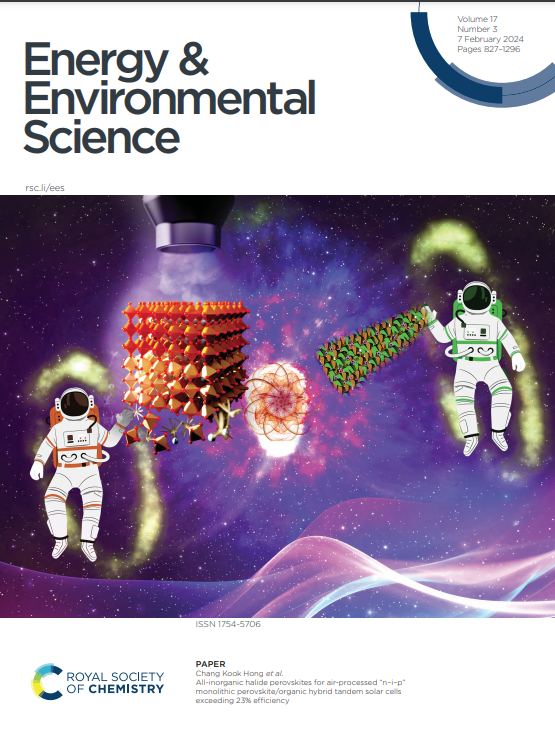Visualizing dynamic competitive reconstruction of trimetallic hybrid catalysts for stable hybrid water electrolysis at large current density
IF 32.4
1区 材料科学
Q1 CHEMISTRY, MULTIDISCIPLINARY
引用次数: 0
Abstract
Glycerol electrooxidation is an intriguing surrogate reaction for sluggish oxygen evolution in water electrolysis and can simultaneously produce value-added chemicals at the anode, however, the majority of non-precious catalysts suffer from large electrolytic voltage and poor stability for hydrogen production via hybrid water electrolysis at large current density. Here we present a hierarchical multi-level triphasic catalyst comprising bimetallic nitride nanoparticles in situ anchoring on biphasic metal sulfides with multilevel interfaces and multifunctional metal sites (Ni3S2/Co9S8/FeNiN). Benefiting from synergistic multi-metal sites and dynamic iron incorporation into the active species, this catalyst manifests extraordinary activity for both the oxygen evolution and glycerol electrooxidation in term of ultralow potentials of 1.502/1.393 V at 300 mA cm-2 and excellent Faradaic efficiency (95.2 %) toward formate production, along with fabulous durability for over 1100/240 hours, placing it among the best non noble metal-based electrocatalysts. Strikingly, by coupling with NiMoN cathode, this catalyst can readily switch from traditional water electrolysis to hybrid water electrolysis with low cell voltages of 1.713/1.610 V to reach 1000 mA cm-2 durably at an electricity-saving efficiency of 6.0 %, outperforming nearly all the biomass upgrading assisted water electrolyzers reported hitherto. Operando Raman and X-ray photoelectron spectroscopic studies reveal the rapid switch from OH*-involved direct oxidation to oxyhydroxide-involved indirect oxidation for glycerol oxidation, which is in sharp contrast to the rapid generation of high-valence metal oxyhydroxide active species for oxygen evolution. Theoretical calculations further substantiate that the construction of dual heterojunction interfaces facilitates the C-C bond cleavage, dehydrogenation and oxygenation steps with much lower energy barriers, thereby promoting the selective oxidation of glycerol into formic acid.大电流密度下稳定杂化水电解三金属杂化催化剂动态竞争重构可视化
甘油电氧化是一种有趣的替代反应,可以在阳极上同时产生高附加值的化学物质,然而,大多数非贵重催化剂的电解电压大,在大电流密度下通过混合水电解制氢的稳定性差。本研究提出了一种由双金属氮化物纳米颗粒组成的分层多级三相催化剂,其原位锚定在具有多层界面和多功能金属位的双相金属硫化物(Ni3S2/Co9S8/FeNiN)上。得益于多金属位点的协同作用和活性物质中动态铁的加入,该催化剂在300 mA cm-2下具有1.502/1.393 V的超低电位,在甲酸生成方面具有优异的法拉第效率(95.2%),同时具有超过1100/240小时的耐久性,是最好的非贵金属基电催化剂之一。引人注目的是,通过与NiMoN阴极偶联,该催化剂可以很容易地从传统的水电解切换到混合水电解,电池电压为1.713/1.610 V,持久达到1000 mA cm-2,节电效率为6.0%,优于迄今报道的几乎所有生物质升级辅助水电解槽。Operando Raman和x射线光电子能谱研究揭示了甘油氧化从OH*参与的直接氧化到OH*参与的间接氧化的快速转换,这与氧演化的高价金属OH OH活性物质的快速生成形成鲜明对比。理论计算进一步证实,双异质结界面的构建以更低的能垒促进了C-C键的裂解、脱氢和氧化步骤,从而促进了甘油选择性氧化成甲酸。
本文章由计算机程序翻译,如有差异,请以英文原文为准。
求助全文
约1分钟内获得全文
求助全文
来源期刊

Energy & Environmental Science
化学-工程:化工
CiteScore
50.50
自引率
2.20%
发文量
349
审稿时长
2.2 months
期刊介绍:
Energy & Environmental Science, a peer-reviewed scientific journal, publishes original research and review articles covering interdisciplinary topics in the (bio)chemical and (bio)physical sciences, as well as chemical engineering disciplines. Published monthly by the Royal Society of Chemistry (RSC), a not-for-profit publisher, Energy & Environmental Science is recognized as a leading journal. It boasts an impressive impact factor of 8.500 as of 2009, ranking 8th among 140 journals in the category "Chemistry, Multidisciplinary," second among 71 journals in "Energy & Fuels," second among 128 journals in "Engineering, Chemical," and first among 181 scientific journals in "Environmental Sciences."
Energy & Environmental Science publishes various types of articles, including Research Papers (original scientific work), Review Articles, Perspectives, and Minireviews (feature review-type articles of broad interest), Communications (original scientific work of an urgent nature), Opinions (personal, often speculative viewpoints or hypotheses on current topics), and Analysis Articles (in-depth examination of energy-related issues).
 求助内容:
求助内容: 应助结果提醒方式:
应助结果提醒方式:


